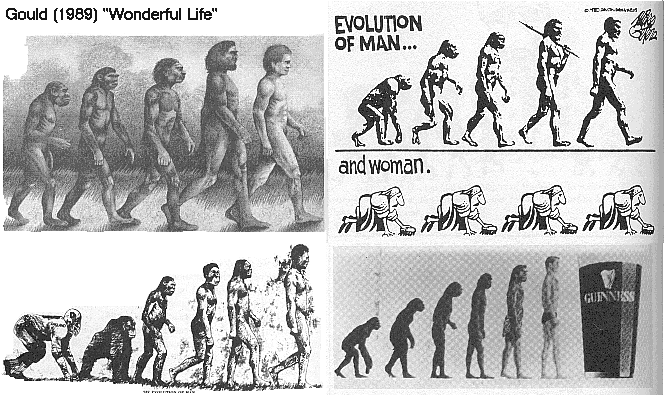You’re probably fairly familiar with some of the iconography associated with human evolution. Here’s a frequently-used image:

and there’s another similar one, which uses a visual joke to make a serious point about where dietary habits in the West may lead us.
In fact, there are a lot of these images around:
You can even buy the t-shirt 🙂
The trouble, as Stephen Jay Gould remarked in his book Bully for Brontosaurus (& again in Wonderful Life), is that this iconography is wrong, wrong, wrong.
For starters, this imagery tends to exemplify the idea that humanity is the pinnacle of life’s evolution, & that all of evolution has been focused on that end. Evolution doesn’t work like that! It’s not directional, not purposeful or goal-oriented, cannot plan for the future. A more considered look at the evolutionary history of life on Earth shows that we occupy a small twig on the side of the ‘mammal’ branch – the fact that we have affected the environment out of all proportion to our place in nature reflects our generalist nature and the pressures selecting for that oversized lump of grey matter inside our skulls.
I had to search around a bit to find this image. A surprising number of trees look more like this, with ‘our’ branch reaching to the top of the tree & other mammalian scions terminating further down – something that again reinforces the idea of the primacy of humans. This one pretty much avoids that trap, & has all living lineages reaching to the top of the tree. What’s more, it uses the length of an individual branch to convey information about how long ago a particular lineage diverged from its nearest relatives; the oldest line of all originates closest to the base of the trunk.
So, we know that evolution doesn’t occur in a linear fashion but in fits & starts, with new species branching off hither & yon. The straight-line view encapsulated in the images I began with owes more to the idea of a ‘great chain of being’ than it does to the fascinating reality. This is as true for our own branch as it is for the tree of life itself:
Even allowing for a certain amount of splitting & lumping (some palaeanthropologists tend to assign a new binomial name to each new fossil find, while others lean to aggregating the remains into fewer species), our family history is bushier than anticipated by earlier workers in this field. I can still remember being taught this stuff in 7th form (year 13) & having it all presented as if one species followed another in a nice tidy sequence. Even the image above falls into that trap a little, with Homo represented by a single line (as much an artefact of the figure’s scale as anything else).
But even within our own genus there is some branching – evolution on a fractal scale? (Go to the original web page for a key to this, eg 10 = Neanderthals & 11 = ‘us’, & much more besides – well worth it for anyone looking for a very readable intro to the literature on ‘Flores man’.)




Marcus Wilson says:
Interesting one this is. How much should we let science be misrepresented to aid a good joke? As a non-biologist, and certainly a non-evolutionary biologist, the pictures at the top are simply amusing (especially the first one). I am sure the artist here didn’t intend to be making serious scientific comment about human evolution, he intended to put together a joke. But does the joke cause people to get the wrong idea? Or at least contribute to someone’s wrong perception? Maybe someone’s done some research on this… (Sounds like a Marsden bid…)
Alison Campbell says:
I don’t actually know if anyone’s done the research… I think it’s more a perception among evolutionary biologists that the frequent use of this ‘progress’ icon (especially in the less jokey iterations) contributes to a misconception, or reinforces an existing misconception, about the nature of evolution.
Worth putting a bid in, you reckon?
Marcus Wilson says:
A bid just might be worth a shot. There’s lots of physics examples of this kind of thing too.
Alison Campbell says:
Would you like to try & put something together?
Grant says:
Has that second image changed, or was it always like that?
Alison Campbell says:
I think it’s always been like that – just checked a couple of my older powerpoint presentations.